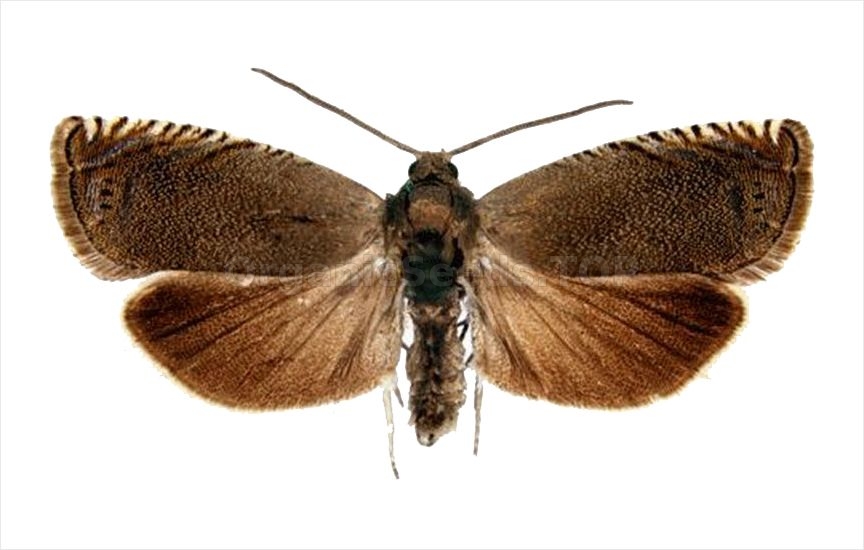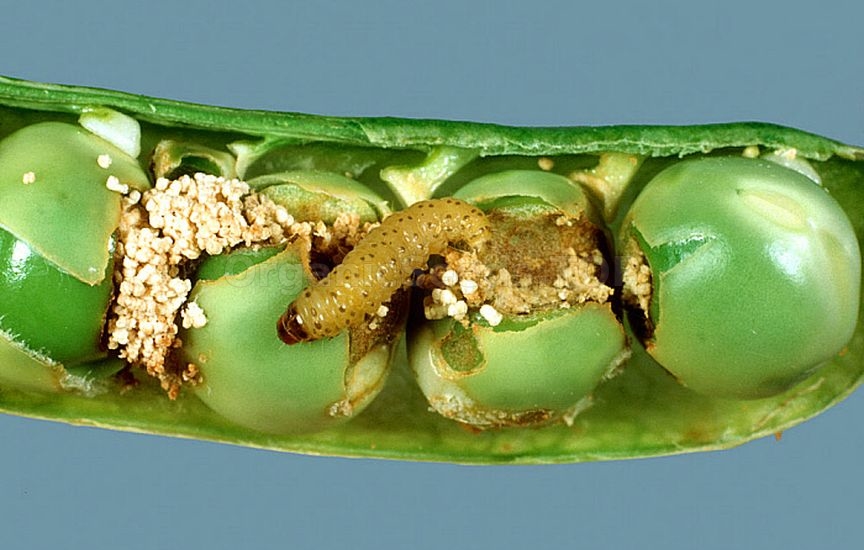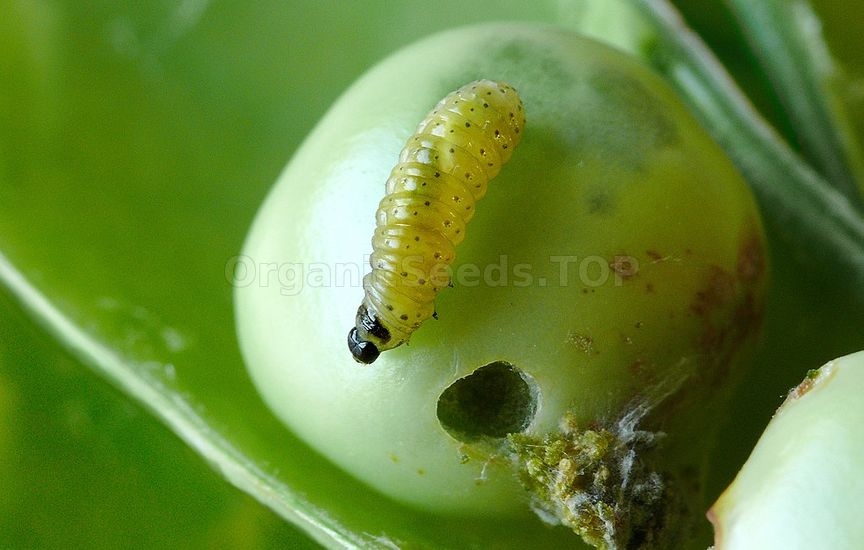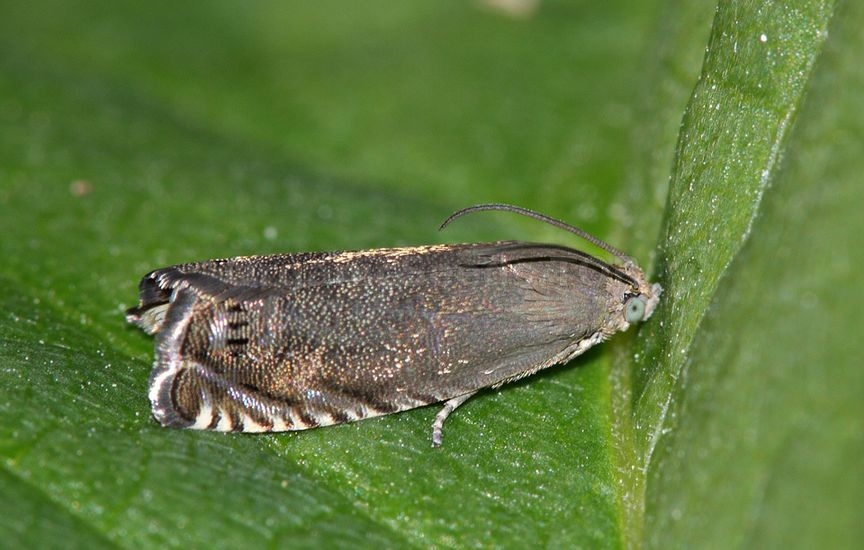 The Pea moth
The Pea moth - is the most important pest of grain peas. Reproduction is bisexual. Development is complete. Caterpillars that have completed their development overwinter. There is one generation per year, but sometimes some of the caterpillars range for two years. Partial second generation is possible in the southern part of the range.
Morphology
Imago
A butterfly with a wingspan from 11 to 16 mm. The color of the front wings is uniform, dark grayish-brown. At the root, the forewings have an olive shade of pollination, in the upper half - yellowish-ocher. The speculum is formed by two bluish-silver lines, dimly shiny, located parallel to the outer edge and with 3-4 black strokes or dots between them. The hind wings are brown, with a slight shade of gray at the root.
Sexual dimorphism
Individuals of different sexes differ in the structure of their genital organs.
Egg
The egg is strongly flattened, oval in shape. Size - 0.75 x 0.6 mm. At the beginning of development, the integument is transparent, watery, later milky white.
 Larva
Larva
Larva (caterpillar) size 12-13 mm. The integument is greenish-white, with a honey-yellow head, anterior thoracic and anal shields of a grayish-brown color, covered with small spots. The body scutes are small, convex, dark brown. The skin is covered with microscopic brown spines. The ventral legs end in a single-tiered crown with 17-20 claws, the anal legs with 12 claws in a single-tiered medial horseshoe.
Pupa
Pupa up to 8 mm in size. The color of the cover is brown. The end of the abdomen is spherically rounded, with 6-8 hook-shaped setae.
Development
Imago
Butterflies appear on peas during the budding phase. The beginning of mass summer coincides with the flowering period of peas. The summer lasts the second half of June and all of July. Females emerge from pupae with underdeveloped ovaries and require additional nutrition. The lower temperature threshold for activity is + 17.2°C.
During the day, butterflies hide and are active in the evening, from 16 to 20 hours, in warm, dry and windless weather. Without food and water, the life expectancy of butterflies is reduced by 2-3 times. In Polesie, females live 6-16 days, some individuals - up to 27 days. In the Western part of Ukraine, the life expectancy of adults is 18 days. The threshold temperature for male activity is + 18°C.
Development
Unfertilized females secrete a pheromone to attract males. The frequency of its release depends on the daily rhythm of activity.
Females begin laying eggs 5-13 days after rebirth. Eggs are placed one at a time, less often 2-4, on the underside of leaves, stipules, flower calyxes, stems, pedicels, and petioles. Over the course of 10-12 days, the female lays an average of 240 eggs in several stages. Maximum fertility - up to 600 pieces.
Egg
Embryonic development at a temperature of 29°C lasts 5 days, at +15.5°C - 24 days. The lower temperature threshold for egg development is + 10-13°C, the sum of effective temperatures is 70-90°C.
Larva
The larva (caterpillar) in the first instar is very mobile. After hatching, it ties thin cocoons and, under their protection, bites into a green bean. Individuals revived to form beans often die within 2-3 days. 80% of the caterpillars penetrate the beans near the top seam, gnawing holes that subsequently quickly become overgrown. In the absence of green beans, the caterpillars die, since they cannot bite into yellowing or drying fruits.
Feeding on stems and buds is noted only as an exception. The short period of mining the bean walls is replaced by gnawing into the grain, in which the caterpillar eats out a large cavity, feeding on the cotyledons. Later, the same grain is eaten from the outside. One caterpillar damages 2-3 grains. There have been cases of cannibalism in young caterpillars. In young beans, after the grains are destroyed, they feed on the tissue of the valves, without passing into other legumes.

On pea beans at a temperature of +34°C, the development of the caterpillar lasts 12 days, at + 15°C - 39 days. The extended period of summer and egg laying leads to the fact that caterpillars can be found even in the north of their range until September. When the beans naturally crack before the caterpillars mature, the latter fasten the valves together with a web. When the grain dries out, the young caterpillars die, and the adult, but underfed, weave a cocoon inside the beans and rest in them, restoring nutrition after the peas get wet as a result of increased humidity.
Caterpillars of the last, usually fifth, instar gnaw holes in the valves with a diameter of 1-1.5 mm and go into the soil, where they are entwined in dense white silky cocoons, surrounded by soil particles, and overwinter. Since up to 50% of the entire population of a pea field is transferred to the windrow, the maximum number of overwintering caterpillars accumulates in the bean windrows. The depth of cocoons depends on the structure and density of the soil and varies from 3 to 25 cm. Overwintering of diapasizing caterpillars ends when the average daily soil temperature rises to a depth of 5 cm above +5°C.
Pupa
In April, the caterpillars leave their winter cocoons, rise to the upper layers of the soil and form long and lush cocoons in which they pupate. The pupal stage lasts from 11 to 18 days depending on the ambient temperature.

Abiotic factors
Basically, one generation of the pea codling moth develops during the year.
The pea moth - is a dangerous pest of grain peas. The larvae are harmful. The vital activity of the pest leads to a decrease in the yield of commercial value and a decrease in the seed quality of forage plants. The loss of similarity can reach 30-40%. Plants with damaged seeds develop slowly and are more damaged by weevils.




